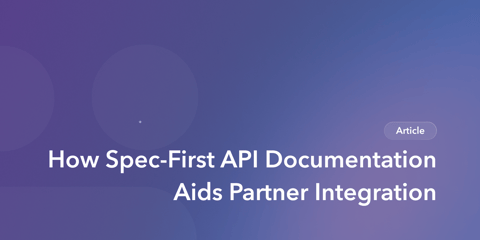Although public APIs like Stripe, Notion, or Twilio tend to get the spotlight, there’s a hidden, deep potential in partner APIs. Opening APIs to select partners can enable collaboration and new revenue streams. But, not all technical leaders, let alone executives, truly realize the benefits a partner API strategy unlocks.
It behooves all technical leaders to consider the high worth of partner API programs. Below, we’ll explore the secret business value of partner APIs, look at example models throughout the market, and consider what sort of data or functionality is exposed. We’ll also consider how to do so safely in regulated areas and tips to yield the best return on investment.
Defining Partner APIs
Partner APIs make up a significant and growing subset of the digital economy. In fact, a 2022 report from RapidAPI found that 49% of developers are already using partner-facing APIs. These initiatives enable co-creation and shared ecosystems to flourish and can be significant revenue-driving activities.
Key differences between public, private, and partner APIs make this option alluring for digital businesses. Whereas public APIs are typically open as part of a greater platform or as a self-service API product, private APIs are for internal use only, such as connecting internal systems or microservices. Partner APIs occupy an interesting middle ground, being served to vetted partners for specific use cases that benefit both parties. They are sometimes even shared with customers to complement core services.
Example Partner API Models
There are a number of partner API models on the market. In some areas, like banking and healthcare, partner APIs arise out of regulatory pressure to expose data to trusted third parties. In other cases, a business intentionally creates APIs to bridge digital gaps, aiding co-creation and opening new monetization pathways.
Revenue Share
Partner APIs can be big moneymakers. For instance, as part of eBay’s partner network, the eBay Buy API allows third-party applications to process orders, providing a share of revenue to the developers. The Buy API impressively hit $1 billion in gross merchandise bought in 2019. An HBR report on the strategic value of APIs shares that eBay generates a staggering 60% of its revenue through APIs.
Revenue share can be an easy win-win for both sides. Another example is the Walgreens Photo Prints API, which offers partners a percentage of sales for every photo ordered using the API. APIs are powering affiliate programs at countless companies, too, from Amazon Selling Partner API to Skyscanner Partners, Shutterstock Affiliate Program, and beyond.
Partner Ecosystems
In many circumstances, a digital alliance between technology partners makes operational sense for both parties, and APIs are the natural conduit. Take the automotive industry, for example, where major manufacturers like Ford, Tesla, and Mercedes-Benz routinely offer APIs to external developers to build innovative user experiences. BMW’s Smartcar is a RESTful service that allows third-party apps to retrieve car data like mileage or battery life, trigger actions like unlock/lock, and more.
Teleco is another area that greatly benefits from API-driven partner collaboration. TM Forum’s Open API project, for instance, is helping communication service providers (CSPs) and vendors to operate more effectively. “Open APIs synergize connected ecosystems of producers and developers to rapidly deliver greater value by accelerating interworking,” says Sandeep Singh, SVP & GM Digital Enablement Business Unit at Mavenir Inc.
Network Expansion
The platform effect is reason alone to consider partner APIs. Without an API, a business is confined to its core capabilities and the user network it has created. But by tapping into external networks and capabilities, partner APIs unlock massive scalability gains.
One case in point is Airbnb, which offers an exclusive API to its [Preferred Partners] (https://www.airbnb.com/software-partners/preferred-partners). These partnerships help Airbnb grow its network, allowing it to seamlessly integrate with external booking sites and vetted property management systems. Or, take Kroger’s suite of partner APIs, which can expose a vast database of Kroger product information for use in scenarios like online purchasing apps. Both examples demonstrate the power of APIs to aid brand awareness and indirectly improve sales.
Regulatory Pressure
As mentioned above, sometimes API-based partnerships arise not due to market expectations but from government-led regulations. The FHIR API standard, for example, is a standard set of rules for exchanging healthcare information in the United States.
Also, worldwide open banking decrees have influenced banks to open financial data to trusted third-party providers. The most notable regulation is PSD2, an EU regulation enacted in 2018. For open banking, APIs not only act as a core means to meet regulatory standards but also as a way to improve the quality of life for end consumers.
That said, there is often hidden value in going beyond what’s legally required. For instance, Nordea, the largest bank in the Nordic region, was an early-mover on open banking, and in addition to meeting financial data sharing requirements, began monetizing their banking-as-a-service components in the process. As of late 2023, they now process 75 million API calls per month.
Partner API Best Practices
As the saying goes, a rising tide lifts all boats. But, determining what sort of data to expose and which partners (or “boats”) to work with is crucial in determining the best outcomes from a partner API strategy. Here are some things to consider along the journey.
- Audit your internal data: Most organizations sit on a treasure trove of internal data — it’s just not structured or exposed. What is the low-hanging fruit? Is there data or functionality others deem useful? You may be surprised to realize what could result in direct revenue streams.
- Balance openness: Open APIs shouldn’t replace your strategic core competency. Look for mutually beneficial partnerships where you exchange data or services on the periphery of your core value. Ensure the ROI is worth it, whether it’s increased revenue, new user experiences, or marketing advantages.
- Expose data safely: Especially within regulated areas, partner APIs must work with sensitive data carefully. These endpoints require high-grade security that involves authentication, authorization, and data encryption.
- Carefully vet partners: One benefit of partner APIs, as opposed to public APIs, is you have more control over who integrates with you. But, this requires due diligence. So, carefully vet potential partners and their technical prowess before providing API keys. You don’t want a Cambridge Analytica scandal on your hands…
Last but not least, partner APIs need just as good developer experience as public APIs. Partner APIs require excellent documentation and usability — otherwise, such programs flounder. “Each partner can have a different way of consuming the API,” says Nagaraja Krovi, vice president at Persistent Systems. “Hence, API adoption and accelerating partner onboarding could face hurdles without a well-designed partner API strategy.”
One such powerful documentation generator is Bump.sh. Tools like this can empower a specification-driven approach to documentation, ensuring your developer resources are up-to-date and impeccably designed, greatly benefiting partner integration.
The Benefits of Partner API Collaboration
Whether the world knows it or not, partner APIs have much hidden value. Their use spans industries, aiding digital business across finance, healthcare, retail, manufacturing, travel, and beyond. As the world relies upon APIs at its core, their value cannot be understated.
Tech partnerships are becoming increasingly important for growth — data is the new oil, and APIs are the pipeline. In this era, treating your business as a platform is crucial to reaching beyond a siloed corporate culture. As such, APIs will only become more entrenched within emerging partner ecosystems as the world becomes more interconnected and digitally reliant.


